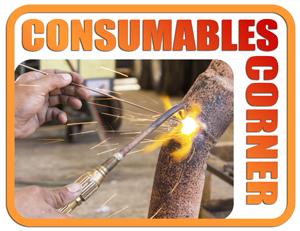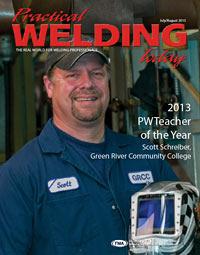Independent welding consumables professional
- FMA
- The Fabricator
- FABTECH
- Canadian Metalworking
Categories
- Additive Manufacturing
- Aluminum Welding
- Arc Welding
- Assembly and Joining
- Automation and Robotics
- Bending and Forming
- Consumables
- Cutting and Weld Prep
- Electric Vehicles
- En Español
- Finishing
- Hydroforming
- Laser Cutting
- Laser Welding
- Machining
- Manufacturing Software
- Materials Handling
- Metals/Materials
- Oxyfuel Cutting
- Plasma Cutting
- Power Tools
- Punching and Other Holemaking
- Roll Forming
- Safety
- Sawing
- Shearing
- Shop Management
- Testing and Measuring
- Tube and Pipe Fabrication
- Tube and Pipe Production
- Waterjet Cutting
Industry Directory
Webcasts
Podcasts
FAB 40
Advertise
Subscribe
Account Login
Search
Consumables Corner: Tackling root penetration problems
- By Nino Mascalco
- June 12, 2014
- Article
- Consumables
Q: We are experiencing weld root penetration issues in our single- and multipass welds. Our base metal is A36, and we oxyfuel-cut it in thicknesses from ½ to 3 in. Most of the weld joints are standard T-joints with a few groove joints. We are using a 0.045-in.- dia. E71T-1C/M flux-cored wire with 75 argon/25 CO2 shielding gas and a 0.045- in.-dia. ER70-S6 with 90 argon/10 CO2. Almost all of the welding is done in the 2F or 1F position. How can we fix this?
A: This is a common problem in many shops and a main concern when considering new welding processes or filler metal and shielding gas mixes. However, many times there is a misunderstanding of what is required for “root penetration.” Generally speaking, root penetration is considered successful if the root of the weld intersects all of the individual components of the base material. For example, a ¼-in. fillet weld bead that penetrates 1/16 to 1/8 in. past the individual components of base material at the root will provide a buffer for manufacturing variations.
A couple things typically contribute to the lack of penetration that you are experiencing: weld joint preparation, shielding gas, filler metal classification, weld parameters, and welder technique.
You should make sure your weld joints are free of heavy mill scale, rust, dirt, or paint. If the weld joint involves a beveled edge that was cut using oxyfuel, be sure there are no gouges or heavy dross that could interfere with welding. Assuming a procedure qualification record (PQR) or welding procedure specifications (WPS) was performed, make sure the welders are staying within the qualified parameters.
Shielding gas plays a key role in arc characteristics, fume generation, weld bead profile, and cleanliness. Argon-rich gas mixes will produce a less penetrating arc. If weld cleanliness and fume generation are not of high importance, simply changing to 100 percent CO2 for the flux-cored arc welding (FCAW) process and 75 argon/25 CO2 for the solid wire (GMAW) process will produce better-penetrating arcs and may resolve your issues.
The other area of concern is that if a majority of the welding is performed in the 1F/2F position, consider changing to a E70T-1C/M (flat and horizontal) filler metal. This is because the all-position flux-cored wire you currently use can sometimes cause problems with lack of penetration because of how the wire/slagging system is designed to perform. Another option you may want to consider is increasing the wire diameter to a 0.052-in. or 1/16-in. flux-cored wire, which can increase your optimal amperage range and produce a better-penetrating arc because of the increase in current.
Finally, your technique is critical to ensuring a sound weld. For FCAW, you should perform a drag technique to keep the arc on the front edge of the weld puddle. This torch drag angle can range anywhere from 5 to 40 degrees, although 5 to 15 degrees is typical. Also, the work angle for a 2F weld should be from 40 to 60 degrees when measured from the horizontal member.
For GMAW, you can use either a push or pull technique without fear of trapping slag at the root. However, it is essential for you to keep the weld arc on the front edge of the puddle with either technique. Typically, welders use a push technique, allowing the welding arc to ride on top of the weld puddle without melt-through. The result of this action is the puddle acts as an insulator, which prevents the arc from penetrating down to the edges of the base metal and causing lack of penetration.
About the Author

About the Publication
Related Companies
subscribe now

The Welder, formerly known as Practical Welding Today, is a showcase of the real people who make the products we use and work with every day. This magazine has served the welding community in North America well for more than 20 years.
start your free subscription- Stay connected from anywhere

Easily access valuable industry resources now with full access to the digital edition of The Fabricator.

Easily access valuable industry resources now with full access to the digital edition of The Welder.

Easily access valuable industry resources now with full access to the digital edition of The Tube and Pipe Journal.
- Podcasting
- Podcast:
- The Fabricator Podcast
- Published:
- 04/16/2024
- Running Time:
- 63:29
In this episode of The Fabricator Podcast, Caleb Chamberlain, co-founder and CEO of OSH Cut, discusses his company’s...
- Trending Articles
Sheffield Forgemasters makes global leap in welding technology

Welding student from Utah to represent the U.S. at WorldSkills 2024

Lincoln Electric announces executive appointments

Lincoln Electric acquires RedViking

Engine-driven welding machines include integrated air compressors

- Industry Events
16th Annual Safety Conference
- April 30 - May 1, 2024
- Elgin,
Pipe and Tube Conference
- May 21 - 22, 2024
- Omaha, NE
World-Class Roll Forming Workshop
- June 5 - 6, 2024
- Louisville, KY
Advanced Laser Application Workshop
- June 25 - 27, 2024
- Novi, MI



























